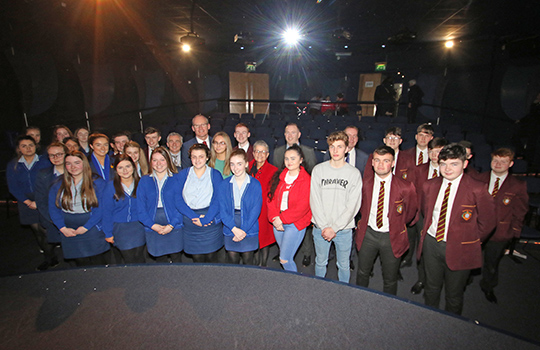Irish Deputy Leader Comes To Downpatrick.

The Tánaiste Simon Coveney TD visited Downpatrick’s St Patrick’s Centre today (Wednesday 17th April 2019).
He was greeted on the front steps on his arrival by St Patrick Centre Director, Dr Tim Campbell and Emma Killen, Chairperson of the Board of Governors.

Simo Coveney, an Irish Fine Gael politician, has served as Tánaiste since November 2017, and has acted as Minister for Foreign Affairs and Trade and Deputy Leader of Fine Gael from June 2017.
After meeting local councillors, MLA’s and MP’s and other dignatories, Mr Coveney was entertained by a group of pupils from Cedar Intergrated Primary School who performed an entertaining, short verion of ‘The Life of St Patrick’.
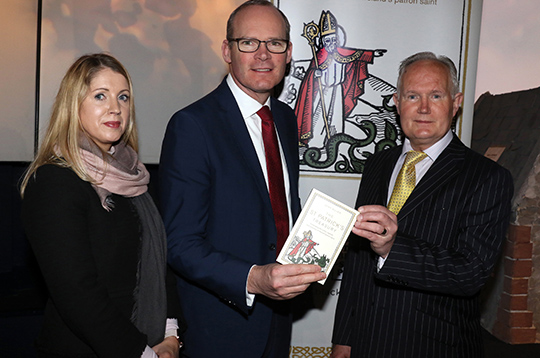
Dr Tim Campbell, Director of the St Patrick Centre, then spoke of the huge impact that St Patrick’s Day has on Ireland adding that ‘the big day’ provided a huge amount of business across the whole of the island of Ireland. “But,” he added, “most people don’t really know much more about their patron saint beyond beer and shamrocks. Therefore, it gives me great pleasure to introduce John Killen, the former Chief Librarian of Linenhall Libray, to introduce his book just published, St Patrick’s Treasury – Celebrating the myths, legends, and traditions of Ireland’s patron saint.”
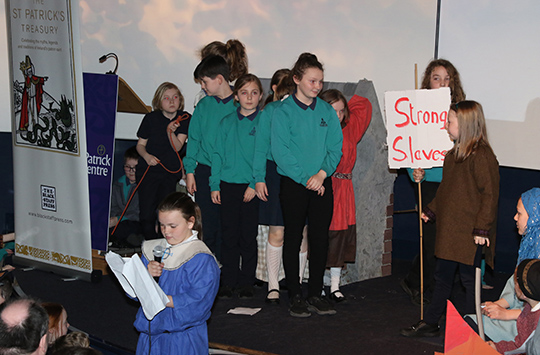
Mr Killen said: “I have addressed St Patrick’s life and legacy. It is a compendium of writings about him. Patrick was not the first saint in Ireland but is certainly the most loved. There is agreement among most scholars that Patrick was born in Hibernia, and after being a slave and escaping, returned in 432AD to begin his mission to convert the Irish to Christianity.”
He discussed Patrick setting up his church in a barn close to the shore of Strangford Lough given to him by Dichui, a local leader. And from there Patrick travelled from his base at Saul around Ireland.
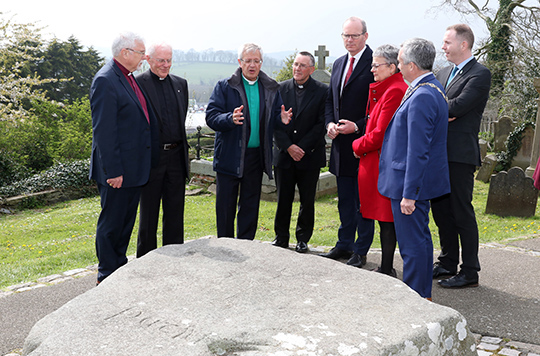
On Patrick’s passing, he said that Patrick probably died in his church at Saul and was driven by a cart and four oxen, which settled on the hill in Downpatrick where he was buried. As was the custom, Patrick’s remains were subject to becoming reliqueries and part of his jaw bone is in Down County Museum today. It was one of the main ones treasured by his flock over the centuries. In fact there are other reliqueries around the world from Dublin to New York.
Mr Killen concluded after discussing the wider works of Patrick and mentioning a number of paintings and stained glass windows: “So I’m hoping that in the year 2032, the 1600 year of his landing at the Slaney River near Saul, that the reliqueries from around the world can come together in an historic exhibition, which could tour round the world, to mark the work of this great saint.”
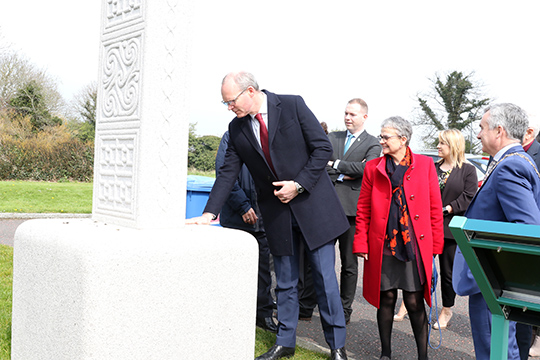
Congratulating John Killen on the publication of his book, Tanaiste Simon Coveney added: “The St Patrick Centre is the only exhibition of its kind in the world. It provides an opportunity to learn about Patrick’s life and times. It is a story about Ireland and the impact Patrick has had on this land.
( CHECK THIS LINK FOR PHOTOS FROM THE TANAISTE’S VISIT. )
“Patrick is buried close by, and this saint is shared by the all of the Christian traditions in Ireland. Just down from Patrick’s grave is a monument too for John Wesley, the founder of the Methodist Church. And in the graveyard at Down Cathedral another great Irishman, Maurice Hayes, has his resting place.
“Patrick has become a global phenomenon. The Great Wall of China and the Pyramids were lit up to celebrate St Patrick’s Day. Main buildings around the world were turned green to mark this day.

“This year St Patrick’s Day was busy across Ireland and beyond … we crossed the world promoting Ireland: 56 countries, 116 cities, 172 high level political meetings, 501 community events, 470 landmarks going green and 215 business events. And St Patrick generated 13.5 million Twiter impressions!
“And as the Good Friday Agreement comes under pressure, St Patrick speaks to a shared heritage across this island. And he should be a force for reconciliation right now.
“There should never he division in this island and we should share the richness of his story… Patrick is a treasure to us all. A treasure to those of faith, and to those with no faith at all. He explains what it is to be a British person in Ireland today. He challenged this island and found courage, redemption and transformation.
“So, failure is unacceptable. We need to protect the Good Friday Agreement of 21 years ago. Many worked to lay its foundations. And civil society is important in this work. This work is needed today now and more than ever,” added Mr Coveney.
The Tánaiste paid a visit to St Patrick’s Grave at Down Cathedral and also placed his hand on the St Patrick’s Cross recently erected, facing the door of the cathedral.
